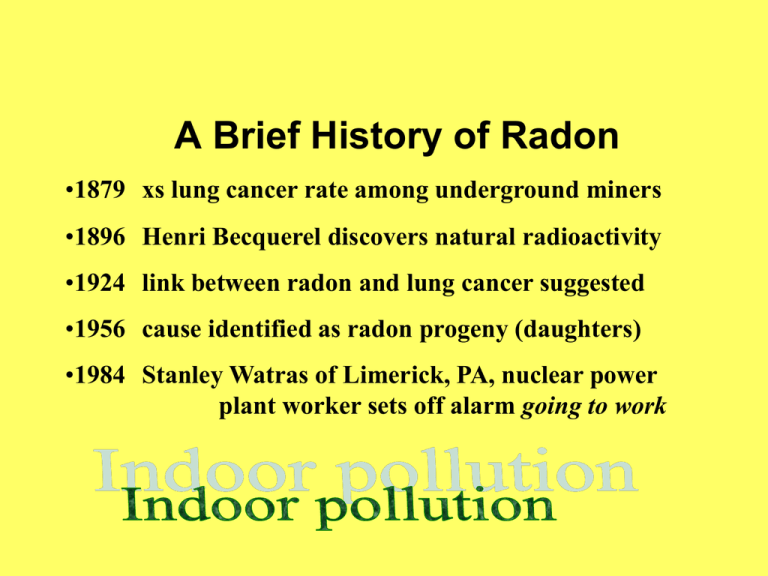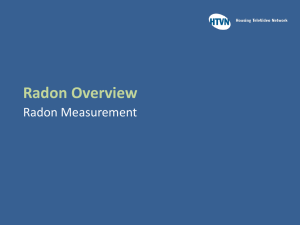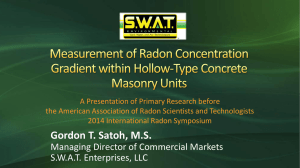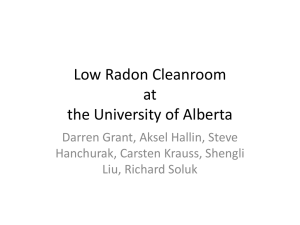Radon
advertisement

A Brief History of Radon •1879 xs lung cancer rate among underground miners •1896 Henri Becquerel discovers natural radioactivity •1924 link between radon and lung cancer suggested •1956 cause identified as radon progeny (daughters) •1984 Stanley Watras of Limerick, PA, nuclear power plant worker sets off alarm going to work Radon decay Natural radioactivity (half-life) in the ground uranium-238 radium-226 4.5 billion years 1600 years radon-222 gas has time to leak into the air almost 4 days lead-210 lead-206 22 years stable radon progeny (daughters) radioactive isotopes of lead, bismuth, and polonium can be inhaled and deposited in the lungs RADON GETS IN THROUGH: 1. 2. 3. 4. 5. 6. 7. 8. Cracks in solid floors Construction joints Cracks in walls Gaps in suspended floors Gaps around service pipes Cavities inside walls The water supply Floor drains BUT DOESN’T GET OUT of tightly sealed homes Sources Sinks (for Rn and progeny) Soil Groundwater Stone building materials Ventilation Plate out (as vapor) Deposition (as particulate matter) “Potential” high low Zone 1 Highest Potential (greater than 4 pCi/L) Zone 2 Moderate Potential (from 2 to 4 pCi/L) Zone 3 Low Potential (less than 2 pCi/L) Tissue penetration (1 MeV) Helium nucleus 10 µm Fast electron 0.5 cm “Light” 1m Tissue damage and repair ↔ illness → death Cell death and replacement ↔ illness → death Disruption of DNA replication → mutation/birth defects Errors in cell repair/replacement → cancer A Soup of Radioactivity Units (Ci) Becquerel (Bq) = 27 pCi 1 decay per second Roentgen Absorption Dose 1 Gy = 1 joule/kg Gray (Gy) = 100 rad Roentgen Equivalent Man (or Mammal) alpha particles are more dangerous than beta particles Sievert (Sv) = 100 rem ROENTGEN Unit of Ionizing Ability in Air = charge created in a volume of air = 1 statcoul/cm3 Unit risk (nonsmoker): 1.8 x 10-2 (pCi/L)-1 [8 x higher for smoker] 1 pCi = 2.2 decays/min = 17,600 Rn atoms 1 pCi/L Rn = 1.9 mSv/yr With more tightly constructed homes, indoor air pollutants are trapped inside Indoor air quality issues: foam blowing insulation, household products, carbon monoxide, molds, vapors from glues and finishes in construction/furniture/fabrics, etc., etc., etc. RADON GAS MEASUREMENT METHODS Activated Charcoal Adsorption Radon is absorbed into a charcoal canister Short-term detector (equilibration over 2-7 days) Laboratory analysis by scintillation (gamma-ray) Alpha Track Detection A plastic film is exposed (1 to 12 months) Alpha particles from radon decay produce damage tracks Number of damage tracks determined Integrating detector Continuous Radon Monitoring (Scintillation counter) Radon decay event causes electric current pulse in device Real-time detector Signal can be electronically integrated (pulse counting) Electret Ion Chamber (Electrostatically charged disk detector) Radon decay ionizes air Air conductivity increases, reducing voltage across chamber Real-time detector Signal can be electronically integrated National Radon Safety Board Radon-Resistant Features The techniques may vary for different foundations and site requirements, but the basic elements are: Gas Permeable Layer This layer is placed beneath the slab or flooring system to allow the soil gas to move freely underneath the house. In many cases, the material used is a 4-inch layer of clean gravel. This gas-permeable layer is used only in homes with casement and slab-on-grade foundations; it is not used in homes with crawlspace foundations. Plastic Sheeting Plastic sheeting seams sealed is placed on top of the gas permeable layer and under the slab to help prevent the soil gas from entering the home. In crawlspaces, the sheeting is placed over the crawlspace floor. Sealing and Caulking All below-grade openings in the concrete foundation floor are sealed to reduce soil gas entry into the home. Vent Pipe A 3- or 4-inch gas-tight or PVC pipe (or other gas-tight pipe) runs from the gas permeable layer through the house to the roof to safely vent radon and other soil gases above the house. Junction Box An electrical junction box is included in the attic to make the wiring and installation of a vent fan easier. For example, you decide to activate the passive system because your test result showed an elevated radon level (4 pCi/L or more). A separate junction box is placed in the living space to power the vent fan alarm. An alarm is installed along the vent fan to indicate when the vent fan is not operating properly.











